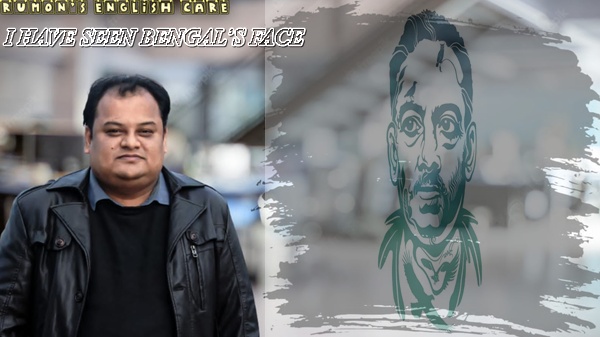I HAVE SEEN BENGAL’S FACE
Unit- 3: Lesson -1
I HAVE SEEN BENGAL’S FACE
Translation of Jibanananda Das’s “Banglar Mukh Ami Dekhiyachi” By Fakrul Alam
Because I have seen the Benga’s face I will seek no more;
The world has not anything more beautiful to show me.
Waking up in darkness, gazing at the f-g-tree, I behold
Dawn’s swallos roosting under huge umbrella-like leaves. I look around me.
And discover a leafy dome- Jam, Kanihal, Bat, Hijol and Asswatha trees-
All in a hush, shadowing clumps of cactus and zedoary bushes.
When long, long ago, Chand came in his honeycombed boat
To a blue Hijal, Bat and Tamal shade near the Champa, he too sighted
Bengal’s incomparable beauty. One day, alas. In the Ganguri,
On a raft, as the waning moon sank on the river’s sandbanks,
Behula too saw countless aswath bats besides golden rice fields
And heard the thrush’s soft song. One day, arriving in Amra,
Where gods held court, when she danced like a desolate wagtail,
Bengal’s rivers, fields, flowers, wailed like strings of bells on her feet.
আমি বাংলার মুখ দেখিয়াছি
জীবনানন্দ দাশের “বাংলার মুখ আমি দেখিয়াছি” কাব্যের ফকরুল আলামকৃত অনুবাদ
যেহেতু আমি বাংলার মুখ দেখিয়াছি, আর কখনো কিছু খুঁজিব না;
সারা বিশ্বে এর চেয়ে সুন্দর আর কিছুই আমার দেখার নেই।
অন্ধকারে জেগে ওঠা, ডালিম গাছের দিকে তাকিয়ে আমি দেখি
ভোরের swallows (পাখি) বিশাল ছাতার মতো পাতার নিচে বসে আছে। আমি চারপাশে তাকাই।
আর আবিষ্কার করি এক পত্রাচ্ছাদিত গম্বুজ – জাম, কনিহাল, বট, হিজল ও অশ্বথ গাছ –
সবকিছু নিস্তব্ধ, ফণীমনসা ও সজিনা গাছের ঝোপকে ছায়া দিয়ে।
যখন বহু, বহু আগে, চাঁদ (সাধক) তাঁর মধুভরা নৌকোয় চড়ে এসেছিলেন
নীল হিজল, বট ও তমালের ছায়ায় চাঁপা ফুলের কাছে, তিনিও দেখেছিলেন
বাংলার অতুলনীয় সৌন্দর্য। একদিন, হায়, গাঙ্গুরি নদীতে,
এক ভেলায়, যখন ক্ষীণচন্দ্র নদীর বালির চরে ডুবে যাচ্ছিল,
বেহুলাও দেখেছিল অসংখ্য অশ্বথ বট স্বর্ণালী ধানক্ষেতের পাশে
আর শুনেছিল শামার দূরের কোমল গান। একদিন, আম্রায় এসে,
যেখানে দেবতাদের আদালত ছিল, যখন সে ম্রিয়মাণ বেগুনি পাখির মতো নাচল,
বাংলার নদী, মাঠ, ফুল, কেঁদেছিল তার পায়ের ঘুঙুরের মতো।
Theme & Summary : The theme of the poem is the timeless and everlasting natural beauty of Bangladesh and the speaker’s patriotic zeal aroused at that. Poet Jibanananda Das is in love with the beauty of his motherland. He feels that his thirst for beauty has been so quenched that he doesn’t need to see the beauty of the world anymore. He sees how generous nature has been to his motherland.
Theme 1: The poet has seen Bengal’s ultimate beauty in its dawn landscapes, trees, and birds. He declares this vision sufficient, comparing it to the mythical experiences of Chand and Behula, for whom Bengal’s natural world—its rivers, fields, and flora—became a transcendent, almost divine, spectacle.
Theme 2: In this poem, the speaker declares that having witnessed Bengal’s serene, natural beauty—its trees, rivers, and dawn—he needs to see nothing else. He links this vision to the mythical experiences of Chand and Behula, for whom the Bengali landscape itself became a divine and poignant spectacle.
এই কবিতায় বক্তা ঘোষণা করেন যে, বাংলার শান্ত ও প্রাকৃতিক সৌন্দর্য—এর গাছ, নদী এবং ভোরের দৃশ্য—দেখে তিনি আর কিছুই দেখার প্রয়োজন অনুভব করেন না। তিনি এই সৌন্দর্যকে চাঁদ ও বেহুলার পৌরাণিক অভিজ্ঞতার সঙ্গে যুক্ত করেছেন, যাদের কাছে বাংলার ভূদৃশ্য নিজেই এক দেবতুল্য ও মর্মস্পর্শী দৃশ্যরূপে প্রকাশিত হয়েছিল।
Theme (Tough One): 3: This poem is a definitive declaration that the speaker’s search for beauty is over, having been fulfilled by the rural landscapes of Bengal. This vision connects him to the mythical past, where figures like Chand and Behula also found the divine and the profoundly beautiful within Bengal’s natural world.
এই কবিতাটি একটি দৃঢ় ঘোষণা যে, বাংলার গ্রামীণ প্রাকৃতিক দৃশ্যাবলী দেখে বক্তার সৌন্দর্য অনুসন্ধান সম্পূর্ণ হয়েছে। এই সৌন্দর্যের দর্শন তাঁকে পৌরাণিক অতীতের সঙ্গে যুক্ত করে, যেখানে চাঁদ ও বেহুলার মতো চরিত্ররাও বাংলার প্রকৃতিতেই দেবতুল্য ও গভীর সৌন্দর্যের সন্ধান পেয়েছিলেন।
Theme: 4: The poet finds supreme beauty in Bengal’s nature—its trees, birds, and rivers. This vision is so complete it eclipses all else, echoing the epiphanies of mythical figures from Bengali folklore, for whom the land itself was a source of transcendent, heartbreaking splendor.
কবি বাংলার প্রকৃতিতে—তার গাছপালা, পাখি ও নদীতে—চূড়ান্ত সৌন্দর্য খুঁজে পান। এই সৌন্দর্যের দৃশ্য এতটাই পরিপূর্ণ যে, তা অন্য সব কিছুকে ম্লান করে দেয়। এটি বাংলার লোককথার পৌরাণিক চরিত্রদের সেই আধ্যাত্মিক উপলব্ধির প্রতিধ্বনি তোলে, যাদের কাছে এই ভূমি নিজেই ছিল এক অতীন্দ্রিয় ও হৃদয়স্পর্শী সৌন্দর্যের উৎস।
Theme 5 (Toughest One) : A definitive aesthetic epiphany: the poet’s encounter with Bengal’s mundane landscape—dawn, trees, birds—culminates in a revelation so absolute it annuls all further seeking. This personal vision is authenticated by its resonance with the archetypal experiences of mythic figures, framing Bengal’s nature as a timeless, self-sufficient realm of beauty.
একটি চূড়ান্ত নান্দনিক উদ্ভাসন: বাংলার নিত্যদিনের প্রাকৃতিক দৃশ্য—ভোর, গাছপালা, পাখি—সম্পর্কে কবির অভিজ্ঞতা এমন এক পরম প্রকাশে পৌঁছায় যা তাঁর সমস্ত অনুসন্ধানকে অবসান ঘটায়। এই ব্যক্তিগত দর্শনটি সত্যতা পায় তার সাদৃশ্যের মাধ্যমে, যা পৌরাণিক চরিত্রদের আদিরূপ অভিজ্ঞতার সঙ্গে মিলে যায়। এভাবেই বাংলার প্রকৃতি রূপ পায় এক চিরন্তন, স্বয়ংসম্পূর্ণ সৌন্দর্যের জগতে।

